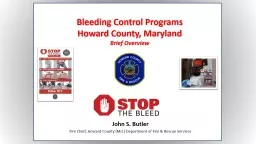

Howard County Maryland Brief Overview John S Butler Fire Chief Howard County Md Department of Fire amp Rescue Services Howard County Maryland Located between Baltimore and Washington DC ID: 605777
Download Presentation The PPT/PDF document "Bleeding Control Programs" is the property of its rightful owner. Permission is granted to download and print the materials on this web site for personal, non-commercial use only, and to display it on your personal computer provided you do not modify the materials and that you retain all copyright notices contained in the materials. By downloading content from our website, you accept the terms of this agreement.
Slide1
Bleeding Control ProgramsHoward County, MarylandBrief Overview
John S. ButlerFire Chief, Howard County (Md.) Department of Fire & Rescue ServicesSlide2
Howard County, Maryland
Located between Baltimore and Washington DCPopulation 299,400254 Square MilesColumbiaA planned community comprising 10 self-contained villagesPopulation 99,60032.2 Square MilesSlide3
Program
OverviewCounty-Wide Hemorrhage Control InitiativeGoal: To reduce the impact of hemorrhage in victims of traumatic injury and to improve mass casualty response by increasing knowledge of hemorrhage control techniques and improving access to hemorrhage control supplies.Key Components:Ensuring that public safety personnel have access to the bleeding control equipment.Public Access Bleeding Control kits co-located with select AEDs throughout Howard County.Bleeding control training
for members of the public safety community and the general public.Slide4
Program Details
Went Live Spring 2016Fire & Rescue: Lead AgencyKey partners include:Howard County PoliceOffice of Emergency ManagementPublic School SystemHoward Community CollegeOther County agenciesRecreation and ParksFacilitiesFleet servicesSlide5
Public Safety
ComponentsCounty PoliceAll officers receive active shooter trainingAll officers are issued IFAK with TQ, Combat Gauze, GlovesPolice supervisors carry mass casualty bleeding control kits.SWAT Officers carry additional gear including chest seals & NPAsTactical Paramedics (Fire/Rescue) ALS skills NDC/Surgical Airway/ALS medsFire RescueDepartment-wide training in active assailant responseBallistic gear being placed on front line apparatusAll personnel trained in “Life Sustaining Interventions” (TCCC/TECC)“LSI” kits placed on apparatus.Mass casualty kits designed around principles of MARCH.Additional mass casualty bleeding control kits on key units.
County-wide joint Police/Fire active shooter response plan.Includes “mixed asset” hybrid teams that focus on LSI & ExtractionJoint training effortsSlide6
Public Access Components
Terminal Goal: Bleeding Control Kits (BCKs) co-located with every county AED (~250 total)Each kit contains 3TQs, 3 Rolls Combat Gauze, Gloves, Trauma Sheers, Pressure Dressings, Just in Time instructions.In addition to 18 mass trauma kits in public safety vehicles (greater quantity of supplies).Initial Goal: 100 BCKs placed at “high risk” locations including (grant funded):Schools, Libraries, Recreation centers, Court houseOther county buildingsSome county agencies purchased additional individual kits out of their operating budget
Additional 170+ individual kits purchased so far.Current Stats (1/2017)
277 Kits placed throughout the countySlide7
Identifying Kit Locations
Schools: Located with the AED in the health suite.All BCK equipped AEDs are labeled.Also geo-tagged.Working with Pulse Point App to indicate BCK equipped AED locations.Slide8
Public Access Bleeding Control Training
PABC programs will only work if people know how and when to use the equipment.National training models continue to emerge. Howard County uses a 1hr version of the NAEMT B-Con course. “Basics of Bleeding Control”High degree of success with our free 1hr CPR course.Trained over 45,000 people in CPR (since 2012).Partnership with schools trains 8,500 6th and 9th graders/yearSince May 2016 trained over 1000 people with a free 1hr bleeding control course.120+ school nurses and health aides trainedWorking with the schools to incorporate this into the health curriculum.Slide9
Implementation
Lessons LearnedOverall concept was widely well received.This stuff is on everyone’s minds.Make this an “all hazards” program.
Be prepared to address issues of Good Samaritan laws.Multiple stakeholders beyond the emergency services.Engage the schools early.
Very hard to “fast track” agency-wide projects, but it can be done.Have a project plan, share the plan, get buy in.A successful training program needs its own sub-plan.Think about downstream costs / funding.Have a plan for volunteers who want to help.Getting the equipment is the easy part!Slide10
End…
Questions?